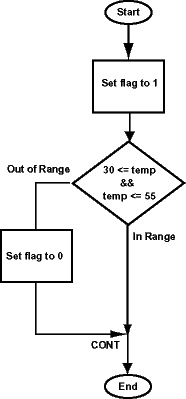Start on the Program
The flowchart for the program is at right. The trick of setting a flag to a default value in advance of the test is common. Here is an outline of the program:

## tempRange.asm
##
## Check that 30 <= temp <= 55
## Set flag to 1 if in range, to 0 if out of range
##
## Registers:
## $2 --- temperature
## $3 --- in/out range indicator flag
## $8 --- scratch
.text
.globl main
# Set range indicator to 1
main: ori $3,$0,1 # set to 1
# Test 30 <= temp <= 55
sltiu $8,$2,_____ # $8=1 if temp <= 55
beq $8,$_____,_____ # 0? out of range
sll $0,$0,0 # delay
. . . . # more instructions
# Out of Range: set range indicator to 0
out:
. . . . # set to 0
# continue
cont: sll $0,$0,0 # target for the jump
## End of file
The range test is in two parts.
The first part (in this program)
tests if temp is less than or equal to 55.
However, the machine instruction is "set on less than".
If temp is out of range a branch is taken to
out.
The branch is followed by a no-op for the branch
delay.